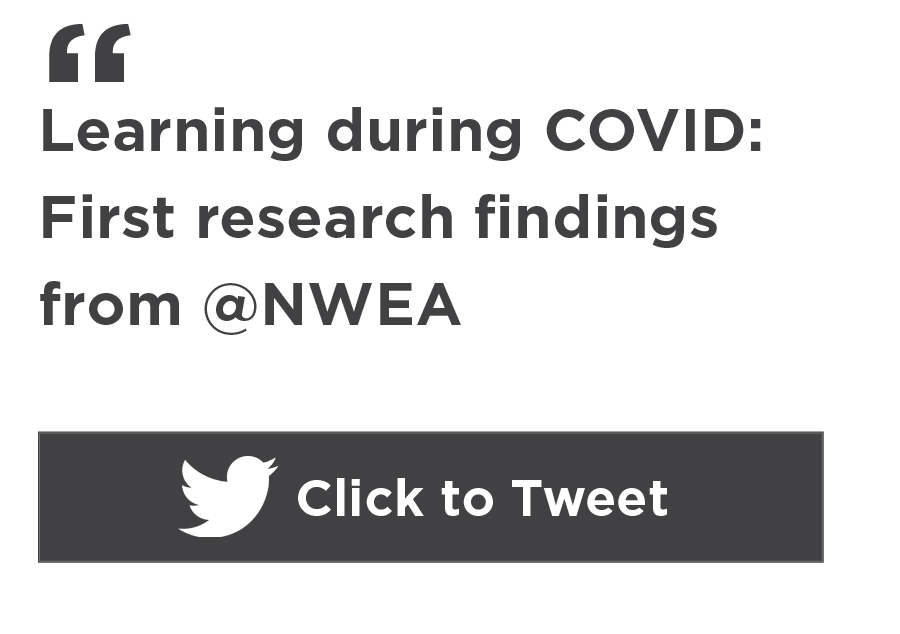The COVID-19 pandemic has disrupted traditional forms of education and continues to create challenges for school systems and the students they serve. Educational leaders and teachers have the unenviable responsibility of making difficult decisions well into the 2020–21 school year and beyond.
In the spring, NWEA released a set of modeled on well-documented summer learning loss estimates. Now, with fall data in hand, my colleagues Megan Kuhfeld, Angela Johnson, Erik Ruzek, Karyn Lewis, and I are ready to share some key findings and actionable takeaways from recent research based on a sample of more than 8,000 schools across the nation.
About the study
Our research focused on exploring how school shutdowns impacted student achievement at the start of the 2020–21 academic year. Using data from nearly 4.4 million students in grades 3–8 who took MAP® Growth™ in fall 2020, we examined the following research questions:
- How did students perform this fall relative to a typical school year (specifically, fall 2019)?
- How has student growth changed since schools physically closed in March 2020?
Key findings
Initial findings are optimistic for reading, suggest unfinished learning in math, and raise equity concerns about missing data on students from underserved communities. More specifically, we offer three key takeaways:
- In fall of 2020, students in grades 3–8 performed similarly in reading to same-grade students in fall 2019, but about 5–10 percentile points lower in math.

- Most students showed growth in both reading and math achievement since the onset of COVID-19 disruptions, but growth in math was lower than in a typical year. (Note: In both charts, vertical red and blue lines display the median growth estimate for winter 2019–fall 2019 and winter 2020–fall 2020, respectively. The black dashed line represents zero growth, e.g., winter and fall test scores were equivalent.)


- Some differences by racial/ethnic groups are emerging in the fall 2020 data, but it is too early to draw definitive conclusions from these initial results. Student groups especially vulnerable to the impacts of the pandemic were more likely to be missing from our fall 2020 data. Thus, we have an incomplete understanding of how achievement this fall may differ across student groups and we may be underestimating the impacts of COVID-19.
Takeaways
In some ways, our findings show an optimistic picture: in reading, on average, the achievement percentiles of students this fall are similar to those of same-grade students last year, and in almost all grades, most students made some learning gains since the COVID-19 pandemic started. In math, however, the results tell a less rosy story: student achievement was lower than the pre-pandemic performance by same-grade students last fall, and students showed lower growth in math across grades 3–8 relative to peers in the previous, more typical year.
It is also important to acknowledge the limitations of our research. Analyses of assessment results cannot help us understand why some students are not present in the fall 2020 testing data. However, two possibilities are that students may not have been tested because they lacked reliable technology or because they have disengaged from school due to economic, health, or other factors. Either scenario presents an urgent call for intervention.
Finally, we are only scratching the surface in measuring the short- and long-term academic and non-academic impacts of COVID-19. And while more students are back in schools now and educators have more experience with remote instruction than when the pandemic began, we are collectively experiencing ongoing changes and disruption. NWEA is continuing to support a robust research program to inform policies and practices enacted to mitigate these impacts; we are explicitly focused on implications for equity, which helps move the nation forward in these difficult times.
Considerations and recommendations
Based on what we’re seeing in the data, we propose the following to educators and policymakers:
- Our findings show that the impacts of COVID-19 disruptions on student achievement were not the blanket declines many expected, but were instead uneven across subjects and grade levels. This indicates there’s a critical need for clear data to understand where students have fallen behind and to guide where additional resources and supports are needed to get them back on track. Schools will also need local data to determine if the trends we observed nationally are reflective of their students.
- School districts and states should collect and transparently report data on students’ opportunity to learn (for example, attendance and completion of assignments) and academic achievement, and they should measure and report on their social and emotional well-being to inform our understanding of students’ unmet needs. We can gain important insights by including data broken out to show any differences for students of color, English language learners, students with disabilities, and students from low-income families, who are all especially vulnerable due to a variety of systemic barriers. As we collectively work to meet these new challenges in education, such crucial information allows educational leaders to best target resources to those most in need.
- Educators and policymakers should plan to provide ample support to students who have fallen behind and, when in doubt, err on the side of more service and outreach. Interventions need to reach not only the students who are receiving instruction but also students who are not. More coordinated efforts are required to establish communication with students who are not attending school or disengaging from instruction to get them back on track. Thus, we echo Bellwether Education Partners’ concerns that there is not enough public recognition of the severity of challenges facing our most vulnerable students nor the ramifications of millions of students continuing to be disconnected from schools. Requiring schools, the public, and nonprofit service agencies to do more with less funding could do even more harm to our most marginalized students. Educational leaders should carefully consider this shift in the students tested and other contextual data as they make decisions on how to best support their students’ growth and recovery.
- Our findings of lower-than-average math gains suggest we should promote equitable access to high-quality math teaching and learning. For example, the National Council of Teachers of Mathematics encourages creative decisions about how students are organized for instruction (for example, to engage in mixed-level groupings both between and within classes), maintaining high expectations for learning, providing differentiated support for each student, and allowing students to move in and out of flexible interventions as needed.
- The safe return to all classrooms and the additional educational and child welfare interventions needed for recovery all require additional funds. Federal and state government leaders must continue to provide funding as the pandemic will have lingering impacts on our children and school systems.
Watch our webinar
Hear more about what we’re seeing in the data and how you can best support your students. Watch “How did COVID impact student learning? The data is in” on demand.









